Cowboys and Aliens behind the scenes
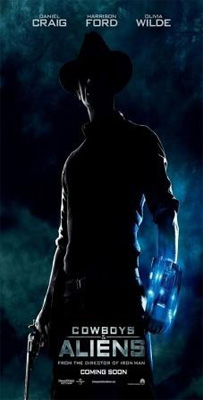
Cowboys and Aliens
Cast: Harrison Ford, Daniel Craig, Olivia WildeDirector: Joe Favreau
Genre: Action, Thriller
Synopsis: 1873. Arizona Territory. A stranger (Craig) with no memory of his past stumbles into the hard desert town of Absolution. The only hint to his history is a mysterious shackle that encircles one wrist. What he discovers is that the people of Absolution don't welcome strangers, and nobody makes a move on its streets unless ordered to do so by the iron-fisted Colonel Dolarhyde (Ford). It's a town that lives in fear.
But Absolution is about to experience fear it can scarcely comprehend as the desolate city is attacked by marauders from the sky. Screaming down with breathtaking velocity and blinding lights to abduct the helpless one by one, these monsters challenge everything the residents have ever known.
Now, the stranger they rejected is their only hope for salvation. As this gunslinger slowly starts to remember who he is and where he's been, he realises he holds a secret that could give the town a fighting chance against the alien force. With the help of the elusive traveler Ella (Olivia Wilde), he pulls together a posse comprised of former opponents-townsfolk, Dolarhyde and his boys, outlaws and Apache warriors-all in danger of annihilation. United against a common enemy, they will prepare for an epic showdown for survival.
Release Date: 11th of August, 2011
Chiricahua Apache: Drawing From History
The American Indians depicted in the story are Chiricahua Apache, who by 1886 numbered less than three-dozen men, women and children. Nonetheless, under the leadership of Geronimo, this small group waged one of the most powerful resistances to the continued Mexican- and U.S.-led incursions into their land. Those who weren't killed were forcibly removed from their lands, and relocated or imprisoned on the other side of the country, where many of them perished.
For Cowboys & Aliens, the filmmakers wanted the representation of American Indians to be as historically and culturally accurate as possible. For information about the Chiricahua, the team turned to New Mexico State University scholar Scott Rushforth and Oliver Enjady, an Apache from the Mescalero Apache reservation.
The filmmakers knew that they wanted their interpretations to be respectful and authentic. Scott Rushforth, who consulted with producers Ron Howard and Brian Grazer on The Missing, and Enjady were invaluable resources to the production. The consultants offered their advice on everything from traditional American Indian ceremonies to local garb and wiki-ups-the thatched huts that Chiricahua women made from brush, leaves and rushes. The men consulted on everything from the script to set, prop and costume design…down to the choice of horses for the Indians. They advised on the intricacies of the war dance and the singing of the song in the wiki-up when Jake takes medicine to remember who he is and what's happened to him. This song was borrowed from and performed by the Mescalero.
Oliver Enjady was the primary liaison between the Mescalero and the production, and he felt a responsibility to his people to make sure the film's representation of them was as accurate as possible. Indeed, in addition to the Mescalero he brought to work as dancers and extras in the film, he brought along four Medicine People, tribal leaders.
The war dance ceremony, with the cast and dozens of Mescalero singing and dancing around the fire, was shot over several nights in the New Mexico desert. The Mescalero designed the ceremonies, the dances and the songs. While it's a somber ceremony, the music and the dance are both lively.
Scott Rushforth and Oliver Enjady also run Ndé Bizaa, the Mescalero Apache language program that works to keep the language and culture alive. Raoul Trujillo, the actor cast to play Chief Black Knife, is actually Apache but didn't speak the language when production began. Trujillo worked tirelessly with digital sound files Enjady and Rushforth had created to perfect his diction and accent. Commends Oliver Enjady: "He really cared to get it right."
Oliver Enjady's help encompassed all aspects of the character of Chief Black Knife. "He helped in the making of the chief, in what the chief has to embody," commends Trujillo. "Every time I went into a scene, I'd have a list in my head of aspects of the character Oliver Enjady gave me that rooted him in harmony, balance, trust and benevolence. I let that creep into my body and my performance."
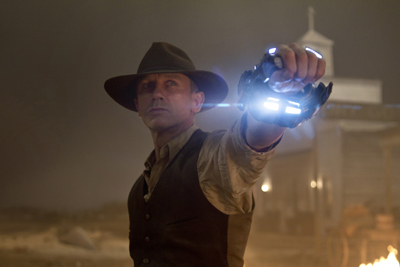 "I was very honored that what we brought helped the project," says Oliver Enjady. He and Scott Rushforth were pleased to see early suggestions about changes to the script come to life before the cameras. In preproduction, Oliver Enjady and Scott Rushforth had conversations with the filmmakers about how Ella might interact with the Apaches when she, Jake, Dolarhyde and the others are taken prisoners by the Indians. They suggested, in keeping with her character, that she reveal that she can speak Apache and they even gave the filmmakers some lines she could say. "I thought it was forgotten," says Oliver Enjady of the conversation they'd had months before, "then, all of a sudden, she was saying what we thought she should say."
"I was very honored that what we brought helped the project," says Oliver Enjady. He and Scott Rushforth were pleased to see early suggestions about changes to the script come to life before the cameras. In preproduction, Oliver Enjady and Scott Rushforth had conversations with the filmmakers about how Ella might interact with the Apaches when she, Jake, Dolarhyde and the others are taken prisoners by the Indians. They suggested, in keeping with her character, that she reveal that she can speak Apache and they even gave the filmmakers some lines she could say. "I thought it was forgotten," says Oliver Enjady of the conversation they'd had months before, "then, all of a sudden, she was saying what we thought she should say." In addition to inviting Mescalero from Southern New Mexico, the production cast American Indians from all over the United States. They found that it was quite difficult to secure people who can ride a horse bareback at full run through the middle of the desert, and after a long casting call, many American Indian nations were represented.
New Mexico, 1875: Locations and Shooting
The landing place for the army of hostile invaders in Cowboys & Aliens is the New Mexico Territory circa 1875. The Civil War has only recently ended, and in the American West, bloody battles raged as Apaches, Navajo and other American Indian peoples fought the expansion of settlers into their lands. Tensions mounted between homesteaders; uncertainty, fear and distrust ruled the land.
More than just a location, the American West is an iconographical landscape, a vast terrain that has become as much a part of film history as it has American history. Places such as Monument Valley, the Alamo and Dodge City are etched into the minds of movie lovers. Keeping the backstory of the Western in mind, the filmmakers looked for a location to make their own, one that could accommodate everything from the first showdown with the aliens in a small town to the miles-long high-speed chases on horseback. They found that and more in New Mexico, the ideal locale for cinematographer Matthew Libatique to shoot Favreau's vision.
The once bustling, vibrant town of Absolution is barely hanging on. Whatever prospects brought people west have dried up, and life exists between a saloon where they can drown their sorrows and a jail, the last bulwark against complete anarchy. All the scenes that take place in the dusty Western town were shot just southwest of Santa Fe at Bonanza Creek Ranch, a working cattle ranch that spans several thousand acres.
"The bones of a town were there, and we built Absolution up around them," explains Roberto Orci of the functional backlot. In fact, as the actor who plays Sheriff Taggart can attest, Westerns have found a home for years in this part of New Mexico. Keith Carradine made one of his first movies-a Western called A Gunfight that starred Kirk Douglas and Johnny Cash-just a mile from Bonanza Creek back in 1970.
It was at Bonanza Creek Ranch that the company shot the opening scenes of Cowboys & Aliens, including the attack on the town. Jon Favreau's crew worked at night, six days a week, to create the footage they would screen for an enthusiastic crowd at July 2010's Comic-Con.
The production headquartered in the capital city of Santa Fe, while the company shot for three months across tens of thousands of acres of land in northern New Mexico. The crew took advantage of a dramatic and diverse landscape, from narrow arroyos in box canyons with 300-foot basalt cliffs on either side, to large swaths of sagebrush- and saltbush-covered open terrain.
With its large tracts of gently rolling high-desert grasslands, San Cristobal Ranch, just 35 miles south of Santa Fe, was home to several key scenes for the film. There, the crew shot the gang camp where Jake has an unwelcome reunion with his old posse, and the Apache camp where Jake, Dolarhyde, Ella, Doc, Nat and Emmett are taken hostage by the Indians. Its vast open space also provided the backdrop for parts of the high-speed chase between our heroes on horseback and the alien speeders flying just above.
In addition to the stunning landscapes of San Cristobal, the Santa Clara Pueblo, the banks of the Rio Grande, Abiquiu Lake and the red sandstone cliffs along the Kitchen Mesa trail at Ghost Ranch, there were locales in New Mexico that seemed tailor-made for a Western in which alien marauders attack. With its oddly beautiful rock formations, Plaza Blanca was one such place that provided the ideal backdrop for the story's climactic confrontation.
Plaza Blanca sits in a small valley on private land in the hills of the Rio Chama Valley in the northern part of the state. For thousands of years, the elements have carved the white sandstone cliffs into unearthly spires that rise hundreds of feet on either side of the arroyo below. It is here that our heroes come across a strange metal structure that towers 80 feet in the air, the temporary home of the alien creatures whom they've come to destroy.
Shooting in the narrow valley required strict coordination for a company of more than 200…not to mention more than 50 trailers, trucks and vans. In addition to tucking every vehicle and piece of equipment out of the sweeping views of DP Libatique's cameras, the company was required to prepare a detailed evacuation plan that would move everyone out of the area in minutes in case of a flash flood.
The incident planning was no exercise in futility. Just weeks before the company arrived to shoot in Plaza Blanca, the greens department was preparing the location by bringing in temporary trees and native bushes to dress the sandy valley. Within minutes, a storm front moved in. The greens men had been instructed to get to higher ground immediately in the event of a storm. It was fortunate, as within 10 minutes the valley floor was literally a rushing river, carrying away all the company's set dressing along a torrent of water.
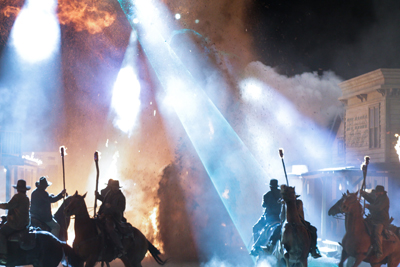 After the company wrapped its shoot in New Mexico, it moved back to Los Angeles. There, stage work continued across the Universal Studios backlot, utilising multiple stages for the subterranean world of the aliens and for the riverboat set, as well as for the acres of lands that would mimic the Southwestern territory.
After the company wrapped its shoot in New Mexico, it moved back to Los Angeles. There, stage work continued across the Universal Studios backlot, utilising multiple stages for the subterranean world of the aliens and for the riverboat set, as well as for the acres of lands that would mimic the Southwestern territory. Aliens Meet Cowboys: Designing the Creatures
Even with the most sophisticated computer-generated imagery available to them, the filmmakers' thoughts returned to the seminal alien-invasion movies with which they'd grown up. Moviemaking technology has advanced rapidly in the 34 years since Spielberg brought his creatures to the screen in Close Encounters of the Third Kind, and the choices for contemporary filmmakers have expanded exponentially.
Jon Favreau wondered if some of the subconscious dimensions of the genre have been lost in the process. "There's a certain timelessness in the way Close Encounters comes across," he says, "a certain unknown quality to the aliens. We're borrowing a lot from classic depictions of aliens, and you see them through the eyes of our lead characters…you get glimpses of them. Think Predator, think Alien: that's the view of aliens we have. They're dangerous, clearly, they have much higher technology, yet there's a very primal brutality to them."
The team's desire to create suspense and horror extended to both the creation and reveal of the film's antagonists. "You want to play the same games that you had to before there was CG," says the director, "to use fear, darkness and imagination when you reveal the alien, to allow it to unfold in a way that has some elegance."
Once again, he harkened back to the films of his youth for inspiration. "We were going for the look and feel and tone of the pre-CG films like Close Encounters, Predator, Alien. Those films played with the mind; those were movies where there was an interplay between audience and filmmaker, and that's just part of telling a good campfire monster story."
Says Jon Favreau of his inspiration: "It's been amazing to pick Steven Spielberg's brain and say, 'How do you use today's technology to present the imagery and the feeling that I felt so strongly when I saw Close Encounters?' There's this ineffable supernatural force that appears. And as great as the special effects are in Jurassic Park, I think about that cup of water on the dashboard. It's how you tease the event, how you build to it when that dinosaur is stepping and you just see the water shaking. So, the first time we encounter the aliens, it's in the parameters of nighttime in this old Southwest town and there's about to be a scuffle. You have our lead characters, and then slowly on the horizon the lights come. Before they know it, aliens are upon them, blowing the town up and snatching people."
To design and build the aliens, the production turned to award-winning Stan Winston Studio principal and alum Shane Mahan and his company, Legacy Effects. In less than two weeks, his team had drawn up 60 designs for the filmmakers.
In addition to creating an heir to some of Shane Mahan's other cinematic aliens, whether the Queen Alien or the Predator, his team looked to create a creature that was unique in both design and mechanics. "It's not just something you haven't seen before," explains Shane Mahan, "but you're also trying to build something that's mechanically innovative and something people can't figure out."
Their alien-part insect, part amphibian, part sea creature-was distinctly different from its predecessors. Rather than creating a suit simply for someone to wear, Shane Mahan created a set of complex multifunctional rigs with interchangeable parts. The result was a towering eight-foot monster with a remote-controlled head, a fully articulated face and horribly malformed arms that protrude from its torso during some of its more disturbing encounters with humans. "It's one of the most technically sophisticated organic pieces that we've done in a long time," says Shane Mahan.
When our heroes seek shelter from the rainy night in the upside-down riverboat that's mysteriously landed in the desert, Emmett is led by his curiosity to wander about. He meanders through the increasingly foreboding space, hears something and freezes, and then all at once, he is face-to-face with an alien. Its horrible head dips down until he and the creature are looking at each other at eye level.
Of the design, Shane Mahan recalls: "Steven Speilberg said that the alien's face had to have personality, recognisable eyes, mouth and brow-something that people could relate to." Built into the multichannel remote-controlled head are some surprises. "In terms of creature design, you have to keep the audience's attention; you have to build in many reveals." At first, the alien is curious, searching Emmett's face, examining him the way you might an insect you've come across. But then, in an instant, it transforms. Its eyes protrude, and it opens its mouth to reveal hideous rows of spiny teeth and oozing goo.
As Shane Mahan explains, there are many advantages to having physical creatures to work with rather than relying solely on ones that are added through CGI. "There's a psychological benefit to seeing something that's actually been photographed. It's dripping, it's doing weird things. People are really reacting to it, and you can sense that intimacy. That helps lend credence to the digital work that happens later."
Jumping in to supplement the work of the special visual effects team was Lucasfilm's Industrial Light & Magic. Under the supervision of award-winning visual effects supervisor Roger Guyett, this group handled the lion's share of visual effects and animation for the project. Top-notch teams at The Embassy Visual Effects, Ghost FX, Fuel VFX, The Garage VFX and Shade FX created additional VFX on Cowboys & Aliens. New Deal Studios and Kerner Optical crafted models and miniatures and contributed special effects for the production.
60 Feet in the Air: Practical Effects and Stunts
Whether it was explosions hitting Absolution or townsfolk being snatched up off the ground from just above, the director was convinced that the more real he could make the threat for the performers, the more compelling it would read on the screen. As production designer Chambliss explains: "Jon Favreau wanted the world we constructed to help each actor bring his or her character to life."
Practical Effects
Because of the production's emphasis on practical effects, the cast and crew were forced to think and act differently on set. "You have to be really creative," says Roberto Orci, "and the storytelling becomes more elegant when you don't have the freedom to do anything you want. It helps the imagination, it helps the audience and allows the CG to be the icing on the cake."
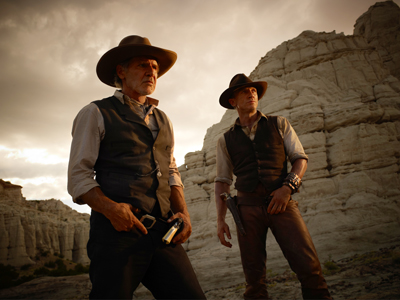 Jake Lonergan is headed for the federal marshal and tethered to Percy, the troublemaking son of cattle baron Woodrow Dolarhyde, when Dolarhyde and his posse come to retrieve Percy from the hands of the law. At the height of the tense standoff between Sheriff Taggart and Dolarhyde, terror comes swooping down upon the small town.
Jake Lonergan is headed for the federal marshal and tethered to Percy, the troublemaking son of cattle baron Woodrow Dolarhyde, when Dolarhyde and his posse come to retrieve Percy from the hands of the law. At the height of the tense standoff between Sheriff Taggart and Dolarhyde, terror comes swooping down upon the small town. To film the first alien assault and create as lifelike an attack as possible, the company brought out livestock, stunt performers and an array of filmmaking hardware. The cast was joined by more than 30 stuntmen and women, 23 horses, two dogs, a goat and two-dozen background extras. Circling them and the small Western town made up of only two intersecting dirt streets was an arsenal of cranes, cables and lights.
The set became an oasis of moviemaking in the middle of the dark New Mexico desert. Suspended on trollies amid more than 300 tons of construction cranes were sophisticated laser lights that moved synchronously as the explosions were detonated below. These blasts were carefully choreographed around the skilled riders on horses that were specially trained to work with pyrotechnics and loud noises. This was completely flanked by 14 additional 80-foot condors outfitted with lighting panels.
Stunts and Animal Work
The cameras capture Doc and Maria as they become separated and the cowboys rear up on terrified horses. As the couple calls out for each other and the street fills with the alien lights and explosions, Doc watches in horror, helpless as his beloved wife is roped by a speeder and hauled up into the sky.
At the height of the attack, Jon Favreau directed that laser lights swoop down on cables, explosions detonate left and right, and people cabled to huge cranes be plucked up 60 feet in the air as if they were marionettes. That kind of mayhem required skillful execution, explains actress Ana de la Reguera, one of several actors who chose to do her own stunts during the alien abduction: "We had to have everything lined up at just the right moment: the horses, the lasers, the yelling, the explosions. Sam and I said our lines, and then at the perfect beat they pulled me up."
The production team had planned for all the roping up of the victims to be executed by stunt performers. But when several of the actors expressed interest in trying it themselves, stunt coordinator and longtime Favreau collaborator Tommy Harper was open to the idea. "We had a new design for the rigs that made it easier," Tommy Harper notes. "We tested it, so we knew it was safe. I started thinking, 'Maybe we can even put some of the actors in it if they're willing. We told them, 'If you're not afraid of heights, we can take you up slowly and progress into it until you're comfortable with the final stunt.'" Keith Carradine and others joined de la Reguera as new members of the film's ad hoc stunt team.
Tommy Harper's crew rigged up the actors and stunt doubles with a special harness that, as it pulled the perfomers up, would actually flip them feet over head and pull them up dozens of feet into the air. To prevent injury, they had to fight their natural inclination to grab the line as they ascended. Fortunately, after many deep breaths and pep talks by the stunt coordinator, they were ready to go.
Most everyone enjoyed his or her flights through the air, but no one more so than Olivia Wilde. Olivia Wilde's abduction happens later in the story as Ella and the others are racing on horseback while being pursued from above by the alien speeder ships. In fact, she is plucked while riding her horse at a full gallop. While the actress is an experienced horsewoman and the stunt was completely safe, it was the first time any actor had ever attempted to do the stunt while riding.
The carefully constructed stunt involved setting a slack line between two cranes that were 135 feet tall and a football field apart. It also required the attachment of a 12-foot, four-part ratchet to a harness worn under the actress' dress. At just the right moment as Wilde was riding her horse, the harness pulled her up 40 feet into the air. It went off without a hitch, and when it was done, the actress was ecstatic. "It was my most exciting moment on the film," Olivia Wilde says.
In addition to alien abductions, there were the more earthbound realities of shooting a Western. The actors had to ride a good deal on horseback, and during the rehearsal period, they trained on the horses with which they would spend much of the next three months. Boss wrangler Clay Lilly worked with the performers to carefully select a horse for each of them. To ensure they didn't buck or kick, the expertly trained animals selected were accustomed to the noise of guns, cannons and explosives, as well as proximity to fire and water.
For Noah Ringer, the production's youngest cowboy, the horse training, which took place on a ranch outside L.A., was just part of the fun. "It was really great," recalls the actor. "I got to ride with Daniel Criag, and that's where I met my horse, Jackson. My favorite thing was to gallop and sometimes I'd pass a few people I wasn't supposed to. We'd have to do the take a few times."
Noah Ringer's other co-star is a dusty dog without a name. The scruffy mutt arrives in Absolution with Jake, but over the course of the story he becomes Emmett's loyal friend and protector. The dog was played by two Australian shepherds named Dart and Aarow, both skillfully trained by handler Eadie McMullen.
The menagerie of livestock certainly helped create an Old West atmosphere. There were more than 100 horses from all over the Southwest, including paints, quarter horses and Appaloosas. To complete the animal cast, there were many cattle, sheep, goats and rats…as well as a Eurasian eagle owl that appears briefly inside the riverboat.
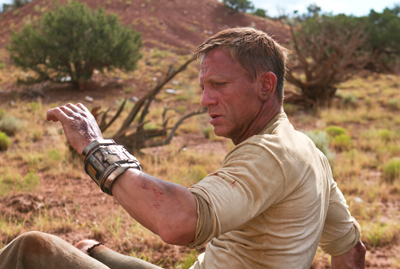 Leather and Lace: Costumes of the Film
Leather and Lace: Costumes of the FilmCostume designer Mary Zophres arrived on this production immediately following another Western, the Coen brothers' remake of True Grit. "It's a historical period for which there are not a lot of photos," she explains. "Between the two films, I think I've seen every photograph from the time."
With the feedback of her Iron Man 2 director, Mary Zophres began creating the look for each of the film's characters, starting with Jake Lonergan. "We had to make him an iconic hero," she explains. "I wanted you to be able to see him from far away and know who he was." To accomplish this objective, Mary Zophres created a silhouette for the laconic stranger-complete with a leather vest, chaps and a signature hat-an outline that would identify him throughout the film.
With the period's reliance on heavy wools, long hemlines and high collars, one of the challenges the designer faced was crafting costumes that wouldn't look dowdy on her performers. Still mindful of the historical details, she notes, "I also wanted the clothes to be flattering and look attractive. We've made a film with some very sexy movie stars."
In this genre's catalog of female characters, there isn't much that rests between saloon girl and prairie woman. Ella falls out of the range of Western archetypes: she is a woman traveling alone through the West. Daniel Craig laughs, "She would have had a bad reputation, I think is the best way to put it."
Ella appears in Absolution, trailing Jake in the shadows and wearing a gun in a belt slung over a pale yellow dress. The inspiration for Ella's dress came to Mary Zophres from a single piece of fabric. "It was something I'd gotten six months before from a vendor who deals with antique clothing and cloth," she recalls. Oddly enough, the most fragile costume on set never saw a rip or tear. "The irony," says Mary Zophres, "was the guys' pants had tons of blowouts up their back seams while Ella's delicate dress never ripped."
The inevitable result of hours on horseback, busted seams kept Mary Zophres' crew busy sewing pants back together. For help with another problem endemic to Westerns, Mary Zophres learned tricks from the real-life cowboys working on the film. In the middle of an elaborate scene with the cast, dozens of horses, multiple cameras and cranes, a hat could fall off and ruin an entire take. She turned to the rodeo crew and background players working behind the camera for advice. "Riding a horse is what these guys do for a living," she says, "and they have all kinds of secrets for keeping their hats on."
Except for one scene in the film, the clothes worn are rough and reflect the unforgiving landscape. In the 1870s, clean laundry-or a change of clothes, for that matter-was a luxury. Mary Zophres advises that the aging of costumes and the distressing and dirtying up of all manner of fabrics and leather are a big part of the making of any Western. "They didn't have washing machines. You were washing things on the side of a rock or in a little tub and hanging them out to dry. The wind was blowing constantly, and there was a layer of dirt on everything you owned. You brought what you could fit in one suitcase, and you wore it and mended it over and over again."
Though our characters have just the clothing on their backs, the production required up to 14 copies of any given outfit, many of which needed to look more worn as the story went along. For Ella alone, there were 17 copies each of her two outfits. The process demanded a team of 30 people, a third of whom were dedicated to aging wardrobe. Once clothes were worn and washed, they were aged again.
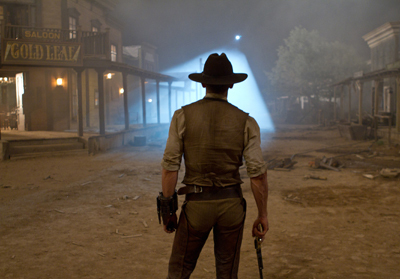 Mary Zophres' commitment to historical detail extended from top to bottom. "Nearly all the clothing at the time was made out of wool, except for most shirts," she explains. "And if it was hot, it was very unpleasant. We had the background players in corsets because it gave them the right silhouette. In those days, it was all about having a small waist. It also helps them have the right kind of posture. Even though they were pioneer women who dressed practically, they were still wearing corsets. All the female background players wore corsets, stockings and garters under their dresses. "They didn't love it at first, but by the end of the day, many said that their backs felt better."
Mary Zophres' commitment to historical detail extended from top to bottom. "Nearly all the clothing at the time was made out of wool, except for most shirts," she explains. "And if it was hot, it was very unpleasant. We had the background players in corsets because it gave them the right silhouette. In those days, it was all about having a small waist. It also helps them have the right kind of posture. Even though they were pioneer women who dressed practically, they were still wearing corsets. All the female background players wore corsets, stockings and garters under their dresses. "They didn't love it at first, but by the end of the day, many said that their backs felt better." Harrison Ford, Daniel Craig, Cowboys and Aliens Interview
www.femail.com.au/daniel-craig-cowboys-and-aliens.htm
MORE
Copyright © 2001 - Female.com.au, a Trillion.com Company - All rights reserved. 6-8 East Concourse, Beaumaris, Vic 3193, Australia.



